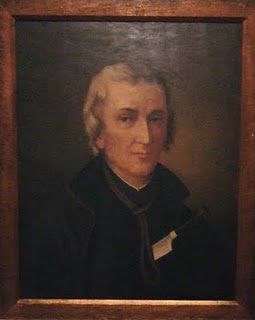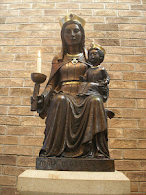Mapledurham Gurney was the larger of two
Manors mentioned in the Domesday Book.
In 1490, the Manor was purchased by Richard Blount. Descendants of Richard Blount still live in
Mapledurham House.
About 1588 Sir Michael Blount felt the
four hundred year old house was not befitting a man of his status so he set
about replacing the old Manor with the present house. Little remains of the old Manor House now.
 |
| Inside the oldest part of the Manor |
 |
| The oldest part of the Manor |
These were difficult and dangerous times
for Catholics. Priests and laypeople
alike were in danger of losing property, liberty, and life itself. Priests conducted their mission in secret and
many were assisted by Catholic gentry who gave them shelter. The priests would say Mass and administer the
sacraments to Catholics in the secret chapels which these recusant gentry
provided in their homes. Catholic Sir
Michael had two secret hiding places, priest holes, constructed off a first
floor bedroom. Located in Oxfordshire,
Mapledurham was on the River Thames and thus an ideal location for a Catholic
Safe House. Priests could approach the
house from the river thereby avoiding the danger of being spotted as a stranger
entering the village on horseback or on foot.
All recusant houses had a secret sign and at the back of this house is a
gable covered with oyster shells. This
could be seen from the River and it was a sign to Catholics that this was a
Catholic house and a safe refuge where Mass was celebrated.
 |
Oyster Shells on the gable
|
 |
The gable with the secret sign,
Oyster Shells on the gable |
With something to interest everyone, this
historic old Manor House is a delight to visit.
The pleasant grounds, the beautiful Anglican Church and the ancient
watermill add to the enjoyment of a visit to Mapledurham. It is also of interest to film buffs as it
has often been used in films and television.
Perhaps the best know film is the 1970s classic, ‘The Eagle Has
Landed’.
I was particularly interested in its
Catholic history which, in my opinion, wasn’t emphasized enough by the guides
who were otherwise very informative and obliging. However, Mapledurham is an important and
interesting part of English history and definitely isn’t just for Catholics!
An interesting fact imparted to us by
one of the guides is that the owners of Mapledurham House are descendants of St
Thomas More, one of the early Reformation Martyrs. In 1814, Charles Eyston married Maria Teresa
Metcalfe who, through her mother, was a descendant of St Thomas More. Mapledurham’s present owner, John Joseph Eyston,
is the great-great-grandson of Charles and Maria. Pictures
of St Thomas More, his father, John More, and his son, hang in the passage
which takes one to what is known as the Staircase Hall.
The library at Mapledurham House holds a
vast collection of antique books, some written by the Antiquary, Charles
Eyston. Many of these valuable books are
Catholic Recusant books, written in Latin.
These 16th and 17th century books would have been
printed on the continent and smuggled into the country. At that time, it was against the law to own
Catholic literature so those who smuggled them into the country, if caught,
faced the death penalty! There are,
too, some of Alexander Pope’s books which he bequeathed to a family member in
1744. A beautifully restored portable
altar, disguised as a writing desk, can also be seen in the library.
Among the many paintings at Mapledurham
House is a curious painting of flowers on a black background. The roses and peonies used in the painting
symbolise mortality. In the middle of
the flowers is an arched black panel.
The guide book tells us that, originally, the Deposition of Christ was
depicted in this panel but it was painted out in the 1600s when Catholicism was
prohibited in England.
Soon after the Second Catholic Relief
Act was passed in 1791 the family built a chapel onto the back of Mapledurham
House. This was one of the first
Catholic Chapels legally built in England since the Reformation. Like others of the time, it was built in the
Strawberry Hill Gothic style and designed to seat about fifty people. We noticed two small statues of the family
martyr, St Thomas More, in the chapel. The Chapel was dedicated to St Michael
in 1797 and Mass is still celebrated there today. The Chapel faces the Anglican Parish Church
of St Margaret and is separated from it by a courtyard.
 |
| The Chapel Entrance |
 |
| Inside the chapel |
There has been a church on the site
since Norman times but the present church was begun in the late 13th
century by William Bardolf and his wife, Juliana de Gournay. Apart from its Norman font, not much of the
original church is evident today. The
beautiful Parish Church of St Margaret is an Anglican church with a Catholic
aisle, the Bardolf Aisle. Curious? Unusual?
Perhaps there are others in the country but I have not encountered this
arrangement before and I find it a very interesting one.
 |
| The Anglican Church of St Margaret, Mapledurham |
Sometime between 1381 and 1395, the south
aisle was added as a chantry chapel and family burial place with an altar at
its east end. When the Blounts bought
the Manor in the late 15th century, the aisle became their property
and their burial place. There are some interesting monuments in the
Bardolf Aisle, including the hatchment of Michael Henry Blount. A hatchment is a large heraldic painting,
originally displayed over the front door of the house of a nobleman upon his
death. After twelve months, the period
of mourning, the hatchment was taken down and brought to the church and hung
above his tomb. (“No trophy, sword or hatchment o’er his bones” Hamlet, Act 4, Scene 5)
.JPG) |
| Some monuments in the Bardolf Aisle |
 |
| The 14th century Bardolf Aisle |
 |
| Michael Henry Blount's Hatchment |
The Bardolf Aisle is separated from the Church
and there has been no direct access between aisle and church for almost five
hundred years. Nonetheless, the Bardolf
Aisle remains a privately owned Catholic aisle within an Anglican Parish
Church.
 |
| The Bardolf Aisle taken from the Church |
.JPG) |
| The Bardolf Aisle & the Parish Church of St Margaret |
On the outside south east wall of the
church, there is a Mass Dial. Mass
Dials, or scratch dials, were usually located near the main door or the priest
door. A mediaeval device, their main
function was to indicate the times of church services.
Then there is Mapledurham
Watermill. This mill, mentioned in the
Domesday Book, has had a chequered history but it is now restored. It is
the oldest working watermill on the Thames. Tours of the mill are available and
it is possible to purchase superb flour from its little shop. I hasten to add that you have not tasted Semolina
Pudding unless you have used Mapledurham Watermill semolina!
 |
Mapledurham Watermill, the oldest working
watermill on the Thames
|
For a great day out, a visit to
Mapledurham House in Oxfordshire is one that will surely please and delight you.
















.JPG)



.JPG)

















.JPG)

.JPG)



.JPG)
